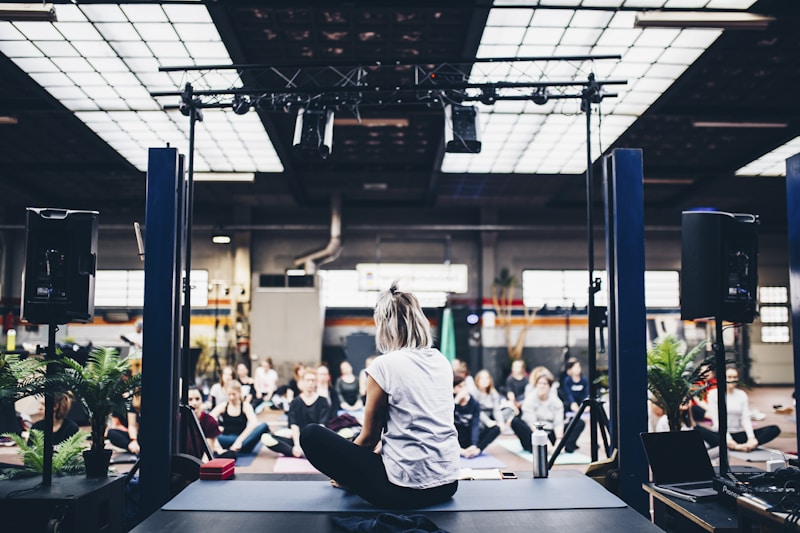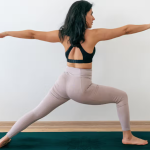Yoga is a fantastic way to tune back into yourself, especially over the Christmas period when over-indulgence and stress can run high. Here Poppy Pickles delves into some yoga techniques for self-care at Christmas.
As the darkness of midwinter encroaches, the barometer plunges and the trees have shed all but a few leaves. We start to feel the natural, animal urge to cosy up, stay indoors and wind down our summer energy.
There is a scientific reason for our instinctive behaviour. Due to our warm-blooded nature, the plummeting temperatures mean that our bodies have to work harder to maintain homeostasis (our constant body temperature). Plus, the cold weather puts stress on our bodies. This causes the release of cortisol, the fight or flight hormone, which can then lead to a compromised immune system. Also, with less daylight, weaker sun, and our skin very much covered up, we are likely to become deficient in Vitamin D, which is crucial to a strong immune system.
On top of these extra physical stresses, we then need to factor in Christmas, which involves the total opposite of cosy-ing up quietly in the warmth. Instead, we find ourselves rushing about like lunatics in the dark, going from Christmas fairs, to school concerts, to late night present shopping and probably sharing a few coughs and colds as well.
How Yoga Can Help
There are plenty of natural ways to increase our bodies’ resistance in these cold, dark months, including a healthy diet with plenty of seasonal foods, keeping warm, and taking vitamin and mineral supplements.
The other natural way we can boost our energy levels for a truly enjoyable, healthy Christmas is through our yoga practice.
Create Repose In Action
With the stresses and strains of daily life in the run up to Christmas, we need to make sure that we make time for a restorative yoga practice. However, there is a way of incorporating the benefits of a restorative practice into our everyday home practice and yoga lessons through finding ‘repose’ within each ‘pose’.
Repose (from the Latin ‘reponere’) means literally to ‘put back’. Through finding repose in our pose, we can restore our dwindling energy reserves. We can do this by adjusting the focus of the practice in three ways:
- Using the breath. If we move on an exhalation, the muscles are less likely to be rigid and forced. ‘Exhalation is freedom’, states B K S Iyengar is his book, Light on Life.
- Focus on relaxing as you hold the pose. This doesn’t mean that the body slumps into inaction, but that the muscles are working without gripping, and there is no unnecessary tension in the brain. To help us relax the brain in an strong pose, it helps to soften the face; release the tongue from the roof of the mouth, and unclench the jaw.
- Look inward during your pose. While keeping your eyes open, take the gaze of the eyes towards the back of the head. The focus of the eyes is soft and you take your attention to the parts of your body you don’t usually focus on. If you close your eyes, you may well lose your balance, but by softening your vision, you then begin the journey of moving the mind into the body.
Head Down Poses
When our body is under physical or mental stress, inversions are the cure-all poses to go to. Headstand, known as the ‘father of all asanas’, is the best way to rejuvenate your brain and boost your immune system.
Going upside down literally floods the brain with oxygenated blood, increasing our brain power and providing a mental boost. The increased blood flow to the head also stimulates the pituitary and the pineal glands, which secrete hormones affecting your moods, energy levels and your ability to grow. It also strengthens the lungs, boosting our ability to fight off chest infections. However, it is important to follow up headstand with shoulder stand, in order to lengthen the neck, and also to cool the body down.
If you haven’t got time (or perhaps the confidence) to do a full headstand, the benefits can be gained through other less strenuous inverted poses, such as Viparita Karani – legs up the wall, setubandha – bridge pose, or by folding your arms above your head and going into uttanasana – standing forward bend.
Re-energise Through Pranayama
The purpose of pranayama, or control of the breath, is to maximise the efficiency of the respiratory system. When we practice breathing to our full capacity, we flood the lungs and the body with energy-giving oxygen, which again helps to top up our bodies’ dwindling energy reserves.
As a parent it can be challenging to find the time to fit in a full home practice, especially when it’s cold and dark and the prospect of getting out of bed any earlier is less than appealing. So why not try to fit in a pranayama practice instead? A complete pranayama practice can take only 15 to 20 minutes, and you will feel the benefits for the rest of the day, or get a better night’s sleep if you fit it in before bed.
All you need to do is find a quiet corner to lie in savasana (corpse pose), with your chest and head raised up on a bolster or blankets. Let the mind and body totally relax in savasana for 5 minutes and then practice becoming aware of your breathing and extending the rhythm of the breath. Once you feel comfortable with this, you can practice 5 breaths with an extended exhalation, gently expelling all the air from the lungs. Repeat this 3 times with normal breathing in between and then practice the opposite, with extended inhalation for 5 breaths, repeating 3 times. Finally, lie for another 5 minutes in savasana.
There are plenty of other pranayama techniques, but when you’re starting out it’s best to keep it simple, otherwise you can run the risk of putting your body under stress, which is the opposite of what we’re going for.
Yoga
Yoga’s final gift to us this Christmas is the simple reminder that yoga means ‘union’. As we approach the end of the year it can be all too easy to focus on the negative. 2016 has been a year of global upheaval, a year when many famous faces that we thought would endure forever have died.
But if we take stock, there is still so much that we have to be thankful for. Simply coming together at this time of year is the real gift. It is the love of our children, parents, friends and family that provides the real warmth and light in this dark end of the year. Yoga is a reminder that the most important thing of all is coming together, being together and remembering what makes us the same.













